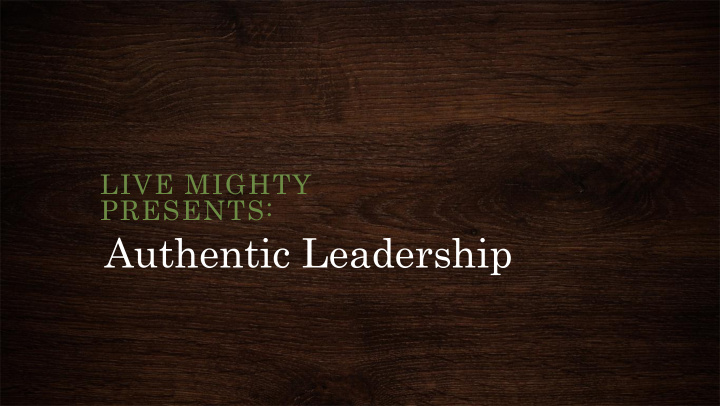



LIVE MIGHTY PRESENTS: Authentic Leadership
What does it mean to be authentic?
Do you feel that your boss is authentic?
What are the characteristics of someone who behaves authentically and someone who does not?
Authentic Leadership
Authentic Leadership • One of the newest areas of leadership research. • No single accepted definition. • Focuses on whether leadership is genuine and “real”
Authentic Leadership • Why a need for authenticity?
Authentic Leadership • Recent scandals and crimes committed by leaders have affected the people’s trust in their leaders.
Authentic Leadership • No single accepted definition. • Multiple definitions, each written from a different perspective and with a different emphasis.
Authentic Leadership Three Perspectives: 1. Intrapersonal 2. Interpersonal 3. Developmental
Authentic Leadership • Intrapersonal Perspective – Focuses on the leader and what goes on within the leader. –Incorporates Leader’s • Self-knowledge • Self-regulation • Self-concept – Exhibit genuine leadership
Authentic Leadership • Intrapersonal Perspective –Eilam’s (2005) description suggests that leaders: • Exhibit genuine leadership • Lead from conviction • Are originals, not copies • Leader’s life experiences are critical to the development of the authentic leader.
Authentic Leadership • Interpersonal Perspective – Focuses on leader-follower relationship – Requires leader and follower responses. – Authenticity emerges from the interactions between leaders and followers. – Reciprocal process because leaders affect followers and followers affect leaders.
Authentic Leadership • Developmental Perspective – Exemplified in Avolio & Gardner’s (2005) work which views authentic leadership as: • Something that can be nurtured in a leader, rather than a fixed trait. • Something that develops in people over a lifetime and can be triggered by major life events, such as a severe illness or a new career
Authentic Leadership • Developmental Perspective – Four Distinct but related components: 1.Self-awareness 2.Internalized moral perspective 3.Balanced processing 4.Relational transparency
Authentic Leadership • Developmental Perspective – Four Distinct but related components: 1. Self-Awareness- refers to the personal insights of the leader. It is a process in which individuals understand themselves, including their strengths and weakness, and the impact they have on others.
Authentic Leadership • Developmental Perspective – Four Distinct but related components: 2. Internalized Moral Perspective- A self-regulatory process whereby individuals use their internal moral standard and values to guide their behavior rather than allow outside pressure to control them.”
Authentic Leadership • Developmental Perspective – Four Distinct but related components: 3. Balanced Processing- An individual’s ability to analyze information objectively and explore other people’s opinions before making a decision .
Authentic Leadership • Developmental Perspective – Four Distinct but related components: 4. Relational Transparency- being open and honest in presenting one’s true self to others. . . . Relational transparency occurs when individuals share their core feelings, motives, and inclinations with others. It includes my showing both my positive and negative aspects of myself to others. In short, relational transparency is about communicating openly and being real in relationships with others.”
Practical Approaches to Authentic Leadership : • Robert Terry’s Approach • Bill Georges Approach
Authentic Leadership • Robert Terry’s Approach: – Action Centered: Focuses on the actions of the leader, • leadership team, or organization in a particular situation. – Advocates that two core leadership questions must be addressed: What is really, really going on? • What are we going to do about it? •
Authentic Leadership • Terry’s Authentic Action Wheel – 6 Components: • Meaning • Mission • Power • Structure • Resources • Existence
Authentic Leadership • Terry’s Authentic Action Wheel How to…. 1. Locate the problem on the diagnostic wheel. 2. Strategically select an appropriate response to the problem.
Authentic Leadership • Bill George’s Approach: – Based upon corporate experience. – Focuses on: Leaders characteristics • Leaders genuine desire to serve • others. The leader knowing themselves. •
Authentic Leadership • Bill George’s Approach: – 5 Dimensions of an Authentic Leader: • Purpose • Values • Relationships • Self-Discipline • Heart
Discovering Your Authentic Leadership “Leadership emerges from your life story.”
Discovering Your Authentic Leadership • How people can become and remain authentic leaders. • Discovered – No need to be born with any universal characteristic traits of a leader.
Discovering Your Authentic Leadership • Authentic leaders begin with understanding the story of their life through self-reflection of: – Difficult experiences – Success stories – Etc..
Discovering Your Authentic Leadership • Authentic Leaders work hard at understanding and developing themselves through: – Self-Reflection – Support networks for honest feedback • Formal and Informal
Discovering Your Authentic Leadership • “The integrity of authentic leaders helps to sustain organizational results through good times and bad.”
Discovering Your Authentic Leadership “Think of your life as a house. Can you knock down the walls between the rooms and be the same person in each of them?”
Discovering Your Authentic Leadership T-Shirt Exercise
Authentic Leadership empowers people to lead! Live Mighty! “And you wanted to hibernate!”
Recommend
More recommend